Did you know that a swimming pool pump…
- Accounts for 25% of your household’s energy bill
- Is the largest electricity consumer in your home
- Uses three times the energy of a refrigerator
- On average costs $427 per year to operate
Recently my wife and I built a swimming pool in our backyard and from a professional standpoint this was such a great learning experience. Building our pool allowed me to test out many of the pool products that I have recommended over the years. During this process I found there were products that I absolutely loved, but at the same time there were a few products that I have recommended on a daily basis that I would not recommend in the future again.
One of my favorite items connected to my pool is my Jandy variable speed pump. It is so quiet, gives me great flexibility with my water features and most important it is extremely energy efficient. During the time period that I was building our pool, I also started to participate quite a bit in a few online swimming pool forums and whenever the topic of pumps would arise I would be eager to suggest a variable speed pump. As I commented on this topic I noticed that there were a few who felt that variable speed pumps were not the best choice and in many cases would suggest a dual speed pump. So, I decided that I would dig a little deeper into this topic and I have shared my findings in this blog post.

The three types of pool pumps explained
First, let’s start with a basic overview of each of the three types of pool pumps on the market today.
Single Speed Pool Pumps (Cost $250-$500)
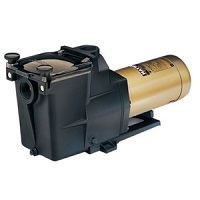
- Highest operational costs
- Least expensive upfront costs
- Operate at a single speed of 3450 revolutions per minute (RPM)
- Operate at a single horsepower ranging from ¾ HP to 3 HP
- Account for 75% of the pool pumps in the USA
Dual Speed Pool Pumps (Cost $500-$700)
- Lower operational cost that contributes to significant operational cost savings
- More expensive than Single Speed Pumps
- Operate at two speeds – 3450 RPM and 1725 RPM
- Operate at two different HPs
- Quiet at low speed
- Difficult to fine tune flow rates
- Additional controller or timer may be needed
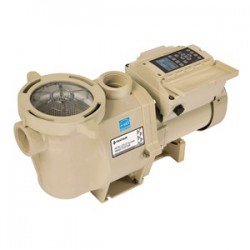
Variable Speed Pool Pumps (Cost $650-$1,200)
- Least expensive pump to operate
- Most expensive upfront costs
- Operate at full range of speeds from 600 RPM – 3450 RPM
- Operate at full range of HPs
- Easy to fine tune flow rates
- Extremely quiet
So why the debate?
The main point of the debate is if you should pay the extra upfront dollars for a pump to reap the rewards of lower operational costs in the future and subsequently how much more should you spend. Should you spend a little bit more on a dual speed pump for pretty good energy savings or should you pay more for a variable speed pump for even greater energy savings and the ability to fine-tune your flow rates?

Why do dual speed and variable speed pumps cost less to operate?
Typically single-speed pumps are too big for your pool. Dual speed and variable speed pumps address this wasted energy as they can operate at different speeds. Running your pump at lower speeds for longer periods of time will cost you much less in operational costs than running your pump at a high speed for shorter periods of time. The energy savings that are gained by replacing a single speed pump with either a dual speed or variable speed pump are based on an engineering principle known as the Pump Affinity Law. Without taking you back to high school algebra class, this principle states that the energy savings are disproportionately larger as you lower the speed of your pump. For example, if you reduce the RPMs of your pump by 50% you don’t get a 50% energy savings you actually get a 75% energy savings and lowering your RPM by 66% gives you an 89% energy savings.
For example if you reduce the RPMs of your pump by 50% you don’t get a 50% energy savings you actually get a 75% energy savings and lowering your RPM by 66% gives you an 89% energy savings.
Is your electricity expensive?
Electricity costs vary widely from state to state and this plays a big factor in determining which pump to choose. You pay for your electricity by the kilowatt-hour (kWh) and the pricing you pay per kilowatt-hour varies greatly from state to state. Dual speed and variable speed pumps use far less kWh than traditional single speed pumps with variable speed pumps using the lowest amount of kWh. If you do not know how much you pay for electricity then this website, The Cost of Electricity for All 50 States, shows you how much you pay. Below I have listed a few of the more popular states and if they fall into the expensive electricity, average electricity or inexpensive electricity categories. Currently, at the time of writing this blog post, the national average in the United States is 12.29 kWh.

Expensive electricity (.30 – .17 kWh) – Traditionally the most expensive areas in the United States for electricity are California, Hawaii, Alaska (a huge pool state), New York and the Northeast.
Average electricity (.11 – .16 kWh) – Florida, Michigan, Ohio, Arizona, and Texas.
Inexpensive electricity (.08 – .10 kWh) – Tennessee, Oklahoma, Louisiana, Kentucky, Mississippi, and West Virginia.
Do you run your pump all year round?
If you live in a warm climate then you will see the potential for greater energy savings than those in cooler climates. This occurs because pool owners in warm climates run their pumps 365 days per year and those in cooler climates shut down their pool pumps for a good percentage of the year. On average pool owners in cooler climates run their pumps 122 days per year. If you run your pool pump 365 days per year in a warm climate then this would be equivalent to three pool seasons in a cooler climate!
Let’s look at the #s
The proof is in the #s so let’s dig into the #s a little deeper. Below I am going to run through a few examples showing the operational costs for a single speed, dual speed, and variable speed pump. Hopefully, this will illustrate how much of an impact electricity cost and climate come into play when determining your pump.
If we take the average size pool of 22,000 gallons and use the guidelines of turning your pool over once per day we come up with the following #s.
Warm Climates
| Pump Type | Energy Use Per Year | Cost to Operate | Savings Per Year | Average Pay Back Time |
|---|---|---|---|---|
| Single Speed Pump | 4714 kWh | $613 | ||
| Dual Speed Pump | 2521 kWh | $327 | $373 | 6 Months |
| Variable Speed Pump | 948 kWh | $123 | $640 | 15 Months |
Note: Example above is using National Avg. for electricity of 12.29 kWh if you live in a state with expensive electricity like California then your savings will be far greater. Calculate exactly how much your pool pump will cost to operate in your state.
Cool Climates
| Pump Type | Energy Use Per Year | Cost to Operate | Savings Per Year | Average Pay Back Time |
|---|---|---|---|---|
| Single Speed Pump | 2723 kWh | $354 | ||
| Dual Speed Pump | 843 kWh | $109 | $244 | 12 Months |
| Variable Speed Pump | 317 kWh | $41 | $312 | 24 Months |
Note: Example above is using National Avg. for electricity of 12.29 kWh if you live in a state with expensive electricity like New York then your savings will be far greater. Calculate exactly how much your pool pump will cost to operate in your state.
Pump payback time
The two biggest factors that determine how fast a dual speed or variable speed pump will pay itself back are:
- Climate
- Cost of energy
In warm climates, you will run your pump 365 days a year meaning you have more opportunity for energy savings. In areas where energy is expensive, the payback will also be quicker.
Just tell me what to get
If your pocketbook can take the additional upfront cost of a dual speed or variable speed pump then I would always suggest one of these pumps as the payback on average takes six months on a dual speed pump and 15 months on a variable speed pump.
In general, my suggestion would be based on if you live in a warm climate or cool climate and secondly if you have expensive energy costs or cheap energy costs.
Warm climate & expensive energy – Variable speed pump
Warm climate & cheap energy – Dual speed pump
Cool climate & expensive energy – Variable speed pump
Cool climate & cheap energy – Dual speed pump

Other Considerations
There are quite a few other considerations apart from the cost of operation that you will want to consider to help you determine if a dual speed or variable speed pump is right for you. Below is a list of these considerations.
Power company rebates
Power companies are offering rebates as high as $400 for switching over to a variable speed pump. In many cases, the power company rebate can make a variable speed pump cost less than a dual speed pump. Make sure to check if your power company offers a Variable Speed Pump Rebate. If so, then it may be a no brainer to opt for a variable speed pump.
Ability to control flow
If you have a lot of bells and whistles connected to your pool like waterfalls, a spa, water features, etc. then I would suggest a variable speed pump as it will allow you to control your water flow for each feature.
Pipe size
Keep in mind your pipe size when selecting your pump as the diameter of your pipe will affect which HP pump you can use. Smaller pipe sizes may not be able to handle large HP pumps. Here is a guide showing the GPM ratings for the most common pool pipe sizes.
| Pipe Size | Flow Rating (GPM) |
|---|---|
| 1-1/12" | 60 GPM |
| 2" | 100 GPM |
| 2-1/2" | 140 GPM |
| 3" | 225 GPM |
This means that if you went with a 3 HP variable speed pump that can output 150 GPM and you only have 1-½” pipe which has a max flow rating of 60 GPMs then the majority of the higher speeds of the pump will go unused as the plumbing is unable to handle this high flow of water.
Additional controller or timer
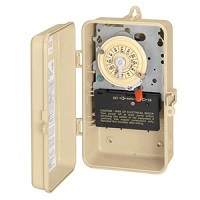
A consideration when looking at dual speed pumps is that in most cases you will need to purchase a separate dual speed timer. The price of this timer ranges between $140-$200 based on your current set up. If your pump is turned on and off by a standard yellow dial timer then you would go the $140 route which is a second timer which controls the switching between high and low speeds where your original timer would be for turning the power on and off to the pump. If you don’t have a timer for your pool or your project is the construction of a new pool then you would need a two clock timer which is the $200 timer. In most cases, for pools with automated control systems, an additional timer is not needed. There are a few systems like the Jandy Aqualink which require a special dual speed relay.
Motor replacement or pump replacement
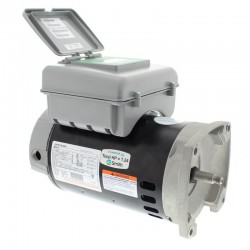
Often there is no need to replace your entire pump and you can save a considerable amount of money by just upgrading your motor to a variable or dual speed motor. So should you replace your entire pump or just your motor? A few questions to ask are:
- How old is your pump?
- Are there visible signs of damage to your pump housing?
- Are parts available for your pump?
In the case of the dual speed pump and motors, it often makes sense to upgrade your motor to a dual speed motor. The reason being is there is a great new motor on the market that has a digital timer mounted directly on the motor meaning that you don’t need to purchase the separate $100-$200 timers indicated above. For some reason unknown to me this digital timer option is only available on replacement motors and not an option on new pumps. Hayward, Pentair, and Zodiac, if you’re listening to this is your next big product and I will only ask for 20% of the revenue…
Pool size (High Stakes Poker)
Typically the larger the pool size the larger the pump which means the operational cost is going to be higher than a smaller pump. So with larger operational costs comes larger operational savings tipping the scales in favor of a variable speed pump on large pools.
Water Features
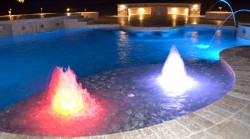
As mentioned earlier one of the key benefits to a variable speed pump apart from operational savings is the ability to control the flow of the pump. This feature comes in very handy if you have water features connected to your pool.
Do you like gadgets?
Many of us like the latest and greatest items on the market. I typically fall into this category. If you wait hours in line for the newest iPhone then you may be a prime candidate for a variable speed pump as they are pretty cool. It is neat to be able to dial your pump into the exact RPM needed and hear the pump ramp up or dial down.
Quiet
If your neighbors are complaining about your pump’s noise then a variable speed may be the way to go. Variable speed pumps are quiet because the motor is Totally Enclosed Fan Cooled (TEFC) meaning that it is much quieter than a single speed or dual speed pump. Often when I have had my pump on at very low RPMs I have to double-check that it is actually on.
In Summary
Your pool pump is most likely the most expensive energy consumer in your house so it makes sense to explore options on how you can minimize this expense. In almost all cases I believe that it makes sense to go with a dual speed or variable speed pool pump over a single speed pump. When choosing between a variable speed pump and a dual speed pump the two most important factors to consider are the cost of your electricity and how often do you use your pool.
Comment below with details about your swimming pool and details about where you live and we will help you determine which pump type is best for you.

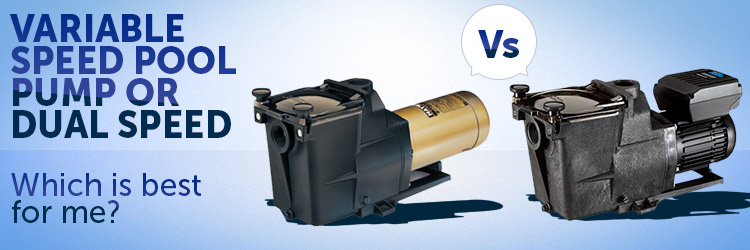
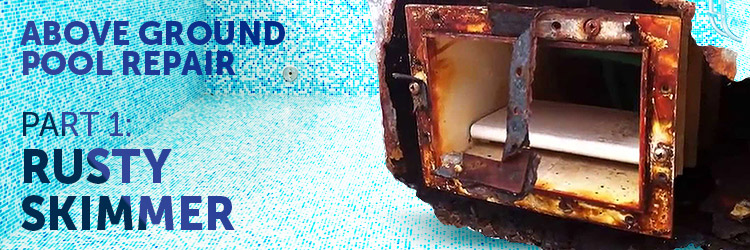
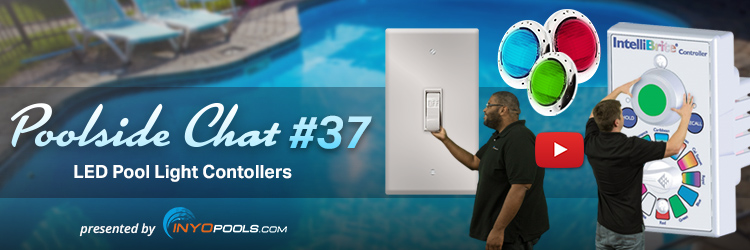
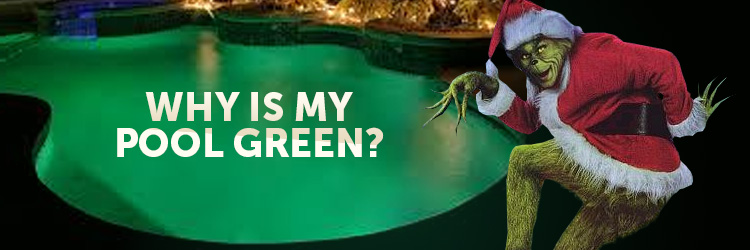
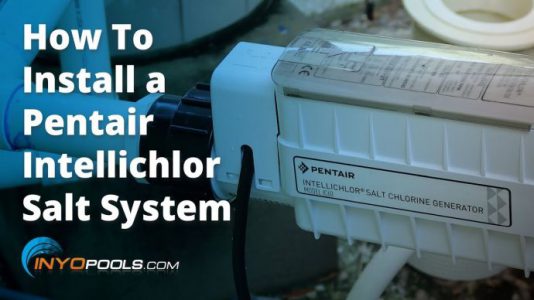






Matthew, does the polaris booster pump work on a low speed dual pump or low rpm setting on a variable pump?
A Polaris Boster Pump – PB460 can be used in series if the dual speed pump is on low. Regarding the variable speed, anything below 1700 RPM is going to be a “test and see” situation.
Hi! We were recommended to go with a variable speed pump. Currently with our filter pump running, the water from the spa overflows into the pool creating a waterfall type feature. We are concerned that with the variable speed the water won’t flow as heavily into the pool and just trickle over. Valid concern? Or what other details do we need to know?
With the 3hp VS pump, do I still need my sweep pump, or will the sweep work when VS is at full hp?
If you have a pressure-side cleaner like a Polaris or a Letro that require a booster pump, then you will still need that booster pump.
These 4 years of interesting comments never mention using a flow meter to match gallons per minute to pool size. Make allowance for the gradually declining filter flow rate to backwash level and this GPM applied to your electric company’s lower tariff hours will indicate the running time required for most economical operation …
Need some advice on replacing pool pump. Live in MIami, 10,500 gal. 2″skimmer 2″ vacuum 1 1/2 return. Want to get variable speed, energy efficient and QUIET. backyard is small and pump is close to pool Would optimally like something that could be “smart” and operated remotely so i can turn on heat when not at home. may add spa in future. Is intelliflo 011018 too much pump or would i just run it at lower setting? Anything else you recommend?? THanks!
Looking for recommendation to replace Hayward Pool Pump model SP3020EEAZ. Pool holds 11,190 gallons and there is also an inground spa/hot tub. Pump is not energy efficient for AZ.
A suitable replacement would be the PureLine Prime 2.7 VS. The pump motor can be throttled to fit your needs to maximize energy savings.
Would this move enough water with the spa and heater? Would this require replumbing or be a “drop-in? Called the support number and they suggested the only pump you carry that would be a suitable replacement was the Hayward Tri Star VS. Would like to try the PureLine if it is indeed applicable.
It will require some replumbing, nothing is going to be an exact drop-in unless it is another Hayward Super II. The TriStar VS would give more flow than the Prime but with the size of your pool being only 11k gallons, you should be able to use the Prime without issue.
First, thanks for all the info! I am installing a 24′ round above ground pool. They have specified a Hayward SP1580 pump which will be mounted below the water level. I am getting a robotic dolphin cleaner which runs on electric, not water flow. I live in PA and my electricity rate is about $0.09/kW.. Are there any benefits to having a VS or DS pump installed?
How would a variable speed pump help if my single speed pump can barely push an adequate volume of water through 3 water features?
I can understand that a VFD or 2-speed pump might lower costs, but I don’t understand how. If it isn’t doing anything other than turning over the water in the pool, unless there are time-of-day electric rate differentials, wouldn’t it be just as efficient to use a smaller pump and run it at a constant rate than to use a VFD? (Our vacuum runs on a separate pump.) Except to take advantage of a time-of-day rate differential, when would the pump need to run at higher or lower rates? I’m interested in some savings, but I’m not sure I can justify it, or even figure out how to calculate it.
The ability to avoid peak hour price surges is a perk; but also remember, lowering a motor’s RPM also decreases energy usage. We cover this subject and the Law of Affinity in the section titled “Why do dual speed and variable speed pumps cost less to operate?” Cutting a motor’s RPMs by 50% lowers the energy use by around 75% or more.
If you decide to go with a lower HP single speed pump, then you’ll still be pulling more amps than if you had gone with the larger dual speed, and run it at the lower setting.
Since the Variable speed pumps use a TEFC motor, does this mean they can essentially cavitate and run dry without overheating? If not how long can the motor be run dry before damage occurs?
We have a new 11,000 gallon pool with a pentair superflo vs. what rpm should this be set at? The pool company set the perimeters and I was wondering if they did it properly? Our pump sounds so loud.
As stated in quite a few of my comments above, setting the RPM for your pool pump depends on the pool size, feet of head, pump model, and chlorine demand.
For the short version since it is already installed, try lowering the RPMs by 300 – 500 RPMs and see if it affects the water quality. If not, lower it some more. If your water quality is affected try to find the middle ground between original and your adjusted setting.
I have a 40,000 gallon pool with an attached spa in South Louisiana with a 2.0 HP single speed pump. Would it make sense to switch to a variable speed pump? We usually run the pump 8-12 hours a day depending on the time of the year.
How much you save and how long it would take to recoup the cost depends on the cost of utility in your area and if rebates are available for the purchase of a new pump. But generally, a variable speed pump can save you a sizeable portion on your power bills even in small pool applications.
Hi Mathew. We’re buildind a new fiberglass pool 11x 22 feet in our backyard and added a pentair water bowl feature. Should we go for a dual speed or a variable pump? Or is the single pump enough? We live in Las Vegas, Nevada.
The magic bowl appears to be a waterfall just in a different configuration. All the things mentioned in the article that you need to consider still apply to your application, regardless of the magic bowl.
Other questions you need to answer. Do you plan to run the waterfall all the time? Or do you plan to have a way to shut off the waterfall either with valves, automation, or if you want to use lower RPM speeds on a multi-speed pump? Does your area require dual or variable speed pumps for new installations? For the last one you need to contact local utility companies.
I need to replace my Hayward pump. It is model SP2607x10. I need the entire pump/motor assembly. Which dual speed pump is right for me
The dual speed replacement is the SP2607X102S
I want to replace Pentair Pinnacle 3/4HP with a 2-speed motor to save energy. Which motor would be perfectly fit for it? Thanks
What is the part, catalog, or model number from the motor label?
If you do not have the above, what is the Service Factor (SF) and Amps?
Question? What is the easiest way to tell or determine if a pool/spa pump motor is a dual speed?
thx
Look on the motor label for the rating that says RPM. If the RPM shows 3450/1725 then it is a dual speed. If the rating only says 3450 then you have a single speed.
Sorry. I should have added I live in northern Ohio and our pool is open from mid May to the first of October.
Matthew,
Thank you for your many insights to pool pumps. I am in process of replacing all my mechanicals for my pool. One item I am considering is a variable speed pump. The added cost I have to factor in though is running a 220V line to the pump. Currently 110V is powering all the mechanicals. I’d love to do the variable speed pump but when factoring in $1000-$1500 to run the power and breakers, it’s a hard nut to swallow.
Current set up:
24,000 gallon in ground. 1 HP single speed pump. Sand filter. 250,000 BTU heater.
Proposed:
1.5 variable speed pump. DE filter. 250,000 filter. Convert to salt generator system.
Thoughts please?
Jim
First, $1000 seems really steep to install a 220-volt line. A couple hundred bucks to install a couple of lines for the pump, SWG, and heater seems more reasonable. I would try to get a new estimate form a different company.
Not knowing your utility costs, pump schedule/ chlorine demand makes giving you an answer on this kind of a guess on my part. But the stuff you have picked out should work well together without much issue. The upfront cost will be high but the longterm should see you save on energy and replacement motors.
I own a pool service in all these people try to sell you a dual speed pump if you live in Florida you put a dual speed pump where it run slower you’re not going to get enough flow through your chlorinate or the keep your pool from not turning green and hot Florida now you’re spending money on a timer the pump more expensive it’s not worth going with the dual speed just go with the higher horsepower so it pumps enough water to your chlorinated to keep that pool nice and nice and blue and no hassles no headaches
If you have waterfalls a hot tub and things like that in your pool then you use a dual speed if not single speed trust me
I have a 22k IG pool and was built with 2 pumps and 2 DE filters. Primary pump is 2.5hp that runs 8hrs/day for pool and spa and has a SWG (Jandy) for chlorination. The other pump is 2 speed pump (2hp/.33hp) that is for catch basin and waterfall. My negative edge pool creates water going over by wind, thus 2nd pump for basin used to ensure catch basin doesn’t overflow and prevents water loss. Other than that, I turn it on high speed when swimming to keep water in pool. Pool co talked me into buying 2nd DE filter given trees around our pool. My question is in regards to VS pumps. Thanks to helpful info on this site, I calculated my 2 pumps yield 30% of my annual electric usage. THIRTY PERCENT! Wow. And that’s not including my polaris booster pump. I want to replace these pumps given I figure to be in this house at least 10 more yrs. For my 2 stage that runs in low speed 24/7 (unless swimming or turning on water feature), what pump would help ensure DE filter is optimally used? Is there a minimum GPM for DE filters? I have an FNS 48 sq ft. filter. I assume I could get the lowest HP (600 RPM – 1/4hp) and use that mode for majority of time 24/7 and then turn it up when needed. I am struggling to calculate my ROI on this 2 stage pump replacement. The main pump is easier. 7723 kWh/yr = $945/yr in electricity. With VS, I could reduce this to around $357/yr. But the current 2 speed pump? The calculation for VS pump from this site is 1 KWH (avg for VS pumps) and my current usage is .805kW. So, 7051 kWh/yr. So other than swimming, all this 2nd pump has to do is keep a very low flow of water circulating back into the pool from the basin….and cleaning the water. But with a DE filter on the main system, I think I have my filtration covered. I will say that my annual cleaning of the 2 DE’s shows the catch basin much more dirty. Thanks for any advice on the VS pump recommendation. I should also note that I have a Jandy One Touch RS and iAqualink controller.
Hi,
I am purchasing a house that has a simple pool without any additional water features or spa etc. A lot of the examples for pump energy savings mention the pros of being able to vary the power depending on when you wanted to power extra features. Wouldn’t I simply run the pool for the amount of time it takes to turn over the water and shut it off? I’m unclear on how this style of pump would be wasting that much energy since it would run for less time than a variable pool.
I do understand that the pumps are more efficient at lower speeds, so i suppose for a simple pool that has no features you’d run your pump at the lowest speed almost 24/7? Is a variable speed pump really going to give me that much savings?
thanks!
Yes, as was the point of the article, variable speed motors can provide great savings in operational cost in the long term. The savings come from the RPM and amp draw of a motor not sliding on the same scale. An easy example of this is to look at a dual speed’s amp usage. A B984 motor uses 11 amps on 3450 RPMs and only 1.8 amps on 1725 RPM. The RPMs were cut in half but the amp usage of the low speed is 16% of that of the high speed. The flow rate on low speed will drop to about a fourth of the high-speed flow rate.
There are a few ways to set up a variable speed: one constant low rpm, lower RPMs during the day peak electricity hours then up the RPMs at night when they lower at night, or choose the middle of your high and low unfor 10-14 hours. Essentially, this decision is dependant on your preferences and utility prices.
Great post and thank you. An infinitypool in Greece directly exposed to sun about 10hrs a day with 6 months summer and size of approx 40,000 operates today with single speed pump of 3hp. Pump is 2 years old and operates well. Would it make sense to change to variable speed for now? KWh cost in Greece is 0.26c. Overflow runs 9-12 hrs a day in summer 5 months and 6 hrs in winter for 7 months. I was thinking what matters is how many gallons filtered in an hour? If this is the cae going with a lower speed requires more time, is the net impact a saving?
thank you
Hello – I’m looking to replace my current pool pump with a variable speed pump. My current pool pump is a 1 HP, 1.65 SFHP Pentair Whisper Flo (Part O-177450-03). I have 2″ piping. The pool is approx. 34,000 gallons, has a waterfall, 2 returns, 2 drain pipes on the bottom (~8ft. deep) and 2 skimmers. The filter is is a Pentair DE, 180008. Filter area is 48 sq. ft w/ a max flow rate of 120 GPM. Last summer I ran the pool pump 11 hours a day, the pool water stayed clean, and the chlorine remained at the appropriate level using a salt water chlorination system.
I was looking at purchasing the Pentair 011018 IntelliFlo Variable Speed High Performance Pool Pump, 3 Horsepower, 230 Volt, 1 Phase – Energy Star Certified pump. Am I over doing it going up to 3 HP? I believe my filter will be able to handle it, I just don’t want to get more power than I need and defeat the purpose of having a variable speed pool pump. If that is too much power, can you recommend a more suitable pump?
No, you are not overdoing it by going with Pentair IntelloFlo 3 HP. Especially for a pool of your size, if you ever have to do heavy duty filtering or a chemical treatment, you’ll be happy you have that extra oomph. Your Pentair FNS Plus have the capacity to handle that pump’s output. But the point of having the variable speed is running the pump at as low of an RPM as possible for longer periods. Your filter would rarely be tested to its limits if the variable speed is scheduled correctly.
Hi-I’m curious about your thoughts regarding a low hp single speed pump compared with a variable speed pump. I live in California and have a simple 23,000-gallon pool, just two skimmers and a sweep (no spa, heater/solar, or water features). I currently have 1.5 hp single speed pump and ¾ hp booster pump and about 40 to 50 feet of head. I would replace with a ½ hp Pentair Whisperflo pump and ¾ booster pump. I’m not sure how to compare monthly energy savings between a ½ hp single pump and a variable speed pump. Especially, considering that the initial investment of the low hp single speed pump is lower than the variable speed pump. Also, my utility company is going to an electricity schedule that will charge extra for use during 12 pm and 12 am in the summer months, which creates an incentive to turn the pool over quicker to avoid the higher rates. I appreciate any thoughts you have. Thanks!
The comparison between the motor is going to based on how long you need to run the pump to turn over your water at least once, and how much it costs to run it in that period. For a 23K gallon pool with 50 feet of head, I would not drop down to a 1/2 HP single speed. You are basically guaranteeing you will need to run the pump in that peak price 12 pm to 12 am slot. If you ever have to do any heavy filtering you’re stuck with a weak pump that will take forever to cycle your water. If you do not want to go variable speed, look at a dual speed 2-Green motor by century. But I would go with a the variable speed, because i am pretty sure you get very good rebates in California for switching to a VS.
Also the booster pump doesn’t come into play because it is purely for the cleaner.